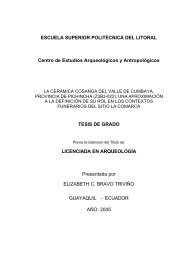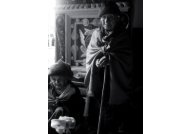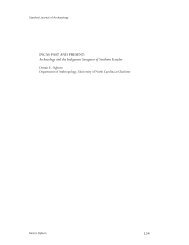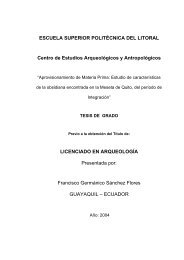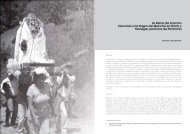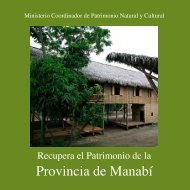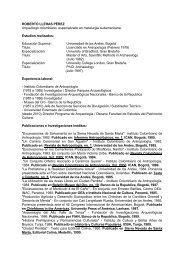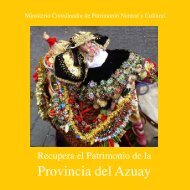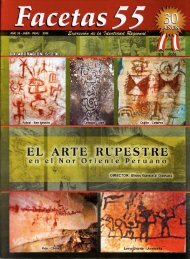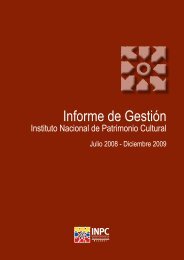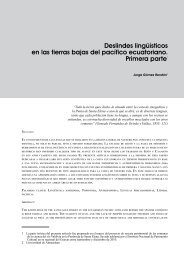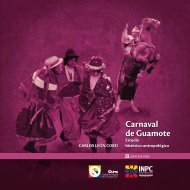Cuadernos de Investigación 8 (PDF) - ArqueologÃa Ecuatoriana
Cuadernos de Investigación 8 (PDF) - ArqueologÃa Ecuatoriana
Cuadernos de Investigación 8 (PDF) - ArqueologÃa Ecuatoriana
Create successful ePaper yourself
Turn your PDF publications into a flip-book with our unique Google optimized e-Paper software.
50 PABLO HERMIDA<br />
Abstract<br />
The Napo Runa ethnic group has been characterized by its historic configuration of binding character and<br />
for having a rich cultural baggage of ethno-medical knowledge. Evi<strong>de</strong>ntly it is an ethnic group that has had<br />
successive contact throughout time, the reason for which it has been revisited in innumerable imaginations<br />
following the established interests and the type of encounters.<br />
We allu<strong>de</strong> to the type of encounter which exploits the sale of ayahuasca rituals on the part of the Shaman<br />
and their family to ethno tourists. It is an encounter which inevitably generates tension, which is shown on<br />
an internal level in the relations of power within the family or the Shaman and the community, and on an<br />
external level as the cultural distance that puts in question the ¨loaning¨ of symbolic co<strong>de</strong>s, which are as<br />
valuable to the Napo runa as they are to the ethno tourists.<br />
The nodal point from which we embark on the present study is the consi<strong>de</strong>ration of Shamanism as the<br />
axis on which the Napo Runa maintain themselves and diversify within a sociocultural context. On this<br />
premise, we will see the forms in which Shamanism operates in this ethnic group focusing on the way in<br />
which the cultural system is un<strong>de</strong>rlined by the gift economy.<br />
This will reveal the type of change that is created by the sale of rituals and the cultural reproduction<br />
adopted as strategies faced with the foreign injections in contemporaneity.<br />
En la región <strong>de</strong>l Alto Napo se asienta un grupo cultural indígena que<br />
está ubicado en las estribaciones amazónicas <strong>de</strong> la cordillera oriental o ceja<br />
<strong>de</strong> montaña, región muy próxima a la Sierra ecuatoriana. Caracterizados<br />
históricamente por ser una etnia que se configura por aglutinación <strong>de</strong> otras y con gran<br />
conocimiento en prácticas etnomédicas, los “Napo Runa” 4 , “Canelos kichwas” o también<br />
llamados “Quijos” han mantenido contacto permanente con actores foráneos a lo largo <strong>de</strong>l<br />
tiempo, lo que naturalmente les ha conducido a incorporar referentes culturales externos,<br />
sobre todo en técnicas <strong>de</strong> salud y en sistemas económicos.<br />
A partir <strong>de</strong> los años 70 el <strong>de</strong>sarrollo <strong>de</strong> la industria petrolera tendió re<strong>de</strong>s viales para<br />
dar cobertura a este vasto territorio <strong>de</strong> selva, lo que condujo posteriormente a facilitar<br />
la industria <strong>de</strong>l turismo en la región, siendo el hábitat biológicamente megadiverso un<br />
elemento altamente atrayente para los turistas. Asimismo, lo fueron sus pobladores<br />
revestidos <strong>de</strong> imaginarios románticos como: “buen salvaje”, “ecologistas naturales”, etc.,<br />
pero sobre todo lo que buscaban los turistas era el contacto con la persona que concentraba<br />
este “exotismo” cultural, y este sin duda era el chamán.<br />
El apogeo <strong>de</strong>l turismo en el Alto Napo sobrevino a finales <strong>de</strong> los años 80, siendo en la<br />
actualidad un importante ingreso económico en la región. Es una empresa relativamente<br />
nueva que oferta activida<strong>de</strong>s variadas, las que se incrementan cada vez más.<br />
Una <strong>de</strong> las activida<strong>de</strong>s ofrecidas sin avisos ni promociones explícitas es la venta <strong>de</strong><br />
rituales tradicionales <strong>de</strong> Ayahuasca con o sin su ingestión, actividad en la que participará<br />
4 Los Napo Runa pertenecen a un solo grupo conocido como “Quichuas <strong>de</strong>l Oriente”, en el que se incluyen los quichuas <strong>de</strong>l<br />
Alto y Medio Napo como <strong>de</strong> la provincia <strong>de</strong> Pastaza.



